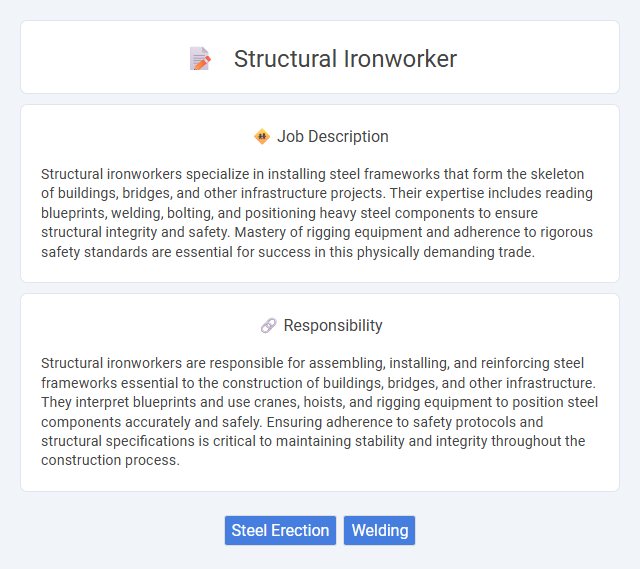
Structural ironworkers specialize in installing steel frameworks that form the skeleton of buildings, bridges, and other infrastructure projects. Their expertise includes reading blueprints, welding, bolting, and positioning heavy steel components to ensure structural integrity and safety. Mastery of rigging equipment and adherence to rigorous safety standards are essential for success in this physically demanding trade.
Individuals with strong physical stamina and a tolerance for working at significant heights are likely to be well-suited for a structural ironworker job. Those who may struggle with confined spaces, fear of heights, or heavy manual labor conditions could find this role challenging. The job probably requires good coordination, balance, and an ability to work in outdoor environments exposed to varying weather conditions.
Qualification
A Structural Ironworker requires a high school diploma or equivalent, combined with specialized training through apprenticeships or vocational programs. Proficiency in reading blueprints, operating welding equipment, and adhering to safety standards are essential qualifications. Physical strength, balance, and experience working at heights enhance job performance and compliance with industry regulations.
Responsibility
Structural ironworkers are responsible for assembling, installing, and reinforcing steel frameworks essential to the construction of buildings, bridges, and other infrastructure. They interpret blueprints and use cranes, hoists, and rigging equipment to position steel components accurately and safely. Ensuring adherence to safety protocols and structural specifications is critical to maintaining stability and integrity throughout the construction process.
Benefit
A structural ironworker job likely offers competitive wages due to the specialized skills required for handling heavy steel frameworks and structural components. Benefits may include comprehensive health insurance, retirement plans, and paid time off, reflecting the industry's emphasis on worker safety and long-term welfare. Opportunities for overtime and union membership possibly further enhance financial stability and job security.
Challenge
The role of a structural ironworker likely involves physically demanding tasks that require precision and adherence to strict safety standards. Challenges may include working at significant heights and handling heavy materials under varying weather conditions. Maintaining focus and coordination in these potentially hazardous environments is probably essential for successful job performance.
Career Advancement
Structural ironworkers can progress from entry-level positions to advanced roles such as crew leaders, foremen, or project managers by gaining experience and specialized certifications. Mastery of welding techniques, blueprint reading, and OSHA safety standards significantly enhances promotion opportunities. Continuous skill development and networking within construction management often lead to higher-paying supervisory or consulting positions in the industry.
Key Terms
Steel Erection
Structural ironworkers specializing in steel erection are responsible for assembling and installing steel frameworks for buildings, bridges, and other infrastructure projects. They read blueprints, operate heavy machinery, and use precision tools to position steel beams and girders securely, ensuring structural integrity and worker safety. Expertise in welding, rigging, and understanding load-bearing requirements is essential for efficient and compliant steel erection processes.
Welding
Structural ironworkers specialize in assembling and securing steel frameworks for buildings, bridges, and other infrastructures, using advanced welding techniques to join metal components with precision and durability. Proficiency in arc welding, MIG, and TIG welding ensures strong, reliable bonds essential for structural integrity and safety compliance. Expertise in reading blueprints and adhering to safety regulations is critical to efficiently perform welding tasks in diverse construction environments.
 kuljobs.com
kuljobs.com